Vhils
(Alexandre Farto)
‘Intrínseco’ – Streetart
Lisbon, Gallery Vera Cortês
2 February – 17 March

Vhils
(Alexandre Farto)
‘Intrínseco’ – Streetart
Lisbon, Gallery Vera Cortês
2 February – 17 March

‘We barely notice when we walk and what we step on, until walking on the pavement provides a surprise’
Ana Cannas. Sidewalks of Portugal. CTT, 2016
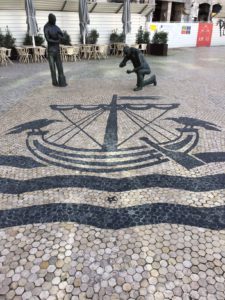 Portugal’s famous pavement originates from the nineteenth century. Under The Lisbon City Council has employed mestres calceteiros ( paving masters) ever since and even founded a vocational school for pavers in 1986. Despite this professional training, pavers have been in short supply for years as their work is hard and badly-paid.
Portugal’s famous pavement originates from the nineteenth century. Under The Lisbon City Council has employed mestres calceteiros ( paving masters) ever since and even founded a vocational school for pavers in 1986. Despite this professional training, pavers have been in short supply for years as their work is hard and badly-paid.
A monument to the paver – a bronze status made by Sergio Stichini in 2006 – can be found on Lisbon’s famous square Restauradores.
 Calçada Portuguesa ( Portuguese-style pavement) is characterized by tight paving with small, irregularly shaped – usually white and black – limestones. Not only ships, animals, stars, flowers, anchors or mermaids inhabit the ground, also geometric patterns show themselves as magnificent stony carpets. Their extraordinary symmetry is impressive in this respect.
Calçada Portuguesa ( Portuguese-style pavement) is characterized by tight paving with small, irregularly shaped – usually white and black – limestones. Not only ships, animals, stars, flowers, anchors or mermaids inhabit the ground, also geometric patterns show themselves as magnificent stony carpets. Their extraordinary symmetry is impressive in this respect.
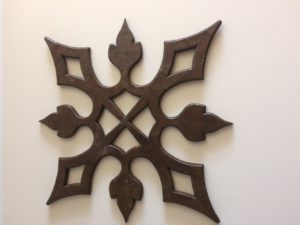 Figures in artistic sidewalks and squares – characterized by the application of stones of different color and shape – were traditionally performed with the aid of wooden molds. The base-color stone, usually white, is first laid around the mold and after removal, the darker stones are fitted inside.
Figures in artistic sidewalks and squares – characterized by the application of stones of different color and shape – were traditionally performed with the aid of wooden molds. The base-color stone, usually white, is first laid around the mold and after removal, the darker stones are fitted inside.
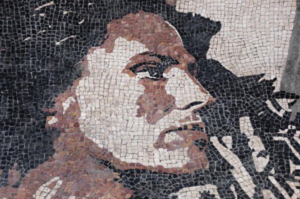 Advantages of mosaic pavement are the use of local materials, its sustainability (stones can be re-used), the ease of removal, the invisibility of restorations (when performed professionally), the efficient drainage and its cultural and touristic value.
Advantages of mosaic pavement are the use of local materials, its sustainability (stones can be re-used), the ease of removal, the invisibility of restorations (when performed professionally), the efficient drainage and its cultural and touristic value.
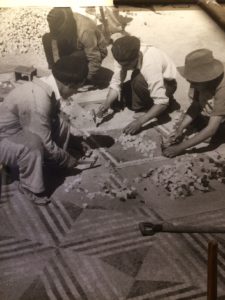
On ramps and steep streets, Portuguese pavement should be adapted by the incorporation of granite stones to increase friction and mitigate the greatest drawback of worn – polished – limestone, becoming slippery when wet!
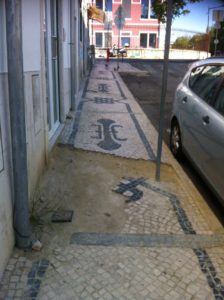
Throughout the years, this beautiful pavement has fallen victim to poor maintenance and repair (stones becoming uneven or loose), causing discomfort when walking, in particular for disabled people.
And take care, these sidewalks are very stiletto-unfriendly!
Bom fim de semana Have a great weekend
Quis sobretudo ser franco ‘I mostly wanted to be frank,
fala aberto o coração! to speak openly from the heart!
Trabalho o preto e o branco By working with black and blank,
sou um ourives do chão. on the ground produced fine art.
( Toni Rosa, paving master and popular poet )
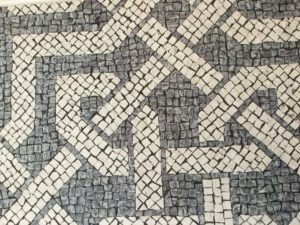 Since Portugal has been declared World’s Leading Destination and Lisbon Best City Break in 2017, I’ am sure you are dying to visit the country in order to see for yourself, whether these prestigious awards are justified. BIG-5. In that case, remember to pay attention to what you walk on because the Portuguese pavement provides a surprise: it is all public art under your feet!
Since Portugal has been declared World’s Leading Destination and Lisbon Best City Break in 2017, I’ am sure you are dying to visit the country in order to see for yourself, whether these prestigious awards are justified. BIG-5. In that case, remember to pay attention to what you walk on because the Portuguese pavement provides a surprise: it is all public art under your feet!
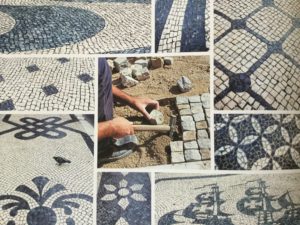 However, that hasn’t always been the case. It started as a forced task performed by prisoners in the nineteenth century. Only later it evolved into a craft and pavers (calceteiros) became recognized artisans, whose art became appreciated in such a way, that it spread to many cities and continents.
However, that hasn’t always been the case. It started as a forced task performed by prisoners in the nineteenth century. Only later it evolved into a craft and pavers (calceteiros) became recognized artisans, whose art became appreciated in such a way, that it spread to many cities and continents.
In 1842 Lieutenant-General Eusébio Pinheiro Furtado –Governor of St. George’s castle in Lisbon – took the initiative of engaging prisoners under his command in the mosaic paving of roads leading to the castle. The chosen pattern was a simple black and white zigzag using limestone and basalt.
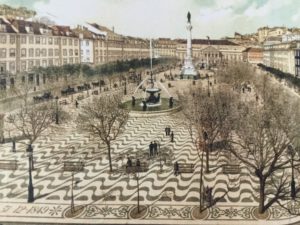 It became an immediate success and similar works were ordered, such as the paving of Lisbon’s major square Praça D. Pedro IV – popularly known as Rossio (meaning ‘wide and public space’) – that took place between 1846 and 1849.
It became an immediate success and similar works were ordered, such as the paving of Lisbon’s major square Praça D. Pedro IV – popularly known as Rossio (meaning ‘wide and public space’) – that took place between 1846 and 1849.
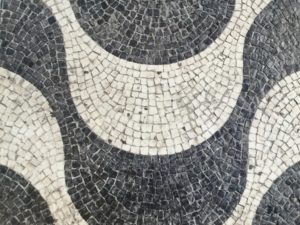 The pavement of Rossio was called ‘Wide Sea’ (Mar Largo) for depicting waves, symbolizing the encounter between the Tagus river and the Atlantic Ocean, which launched the Portuguese into the Discoveries in the 15th century. After Rossio, Lisbon adopted mosaic pavement for all its squares and sidewalks and it became the most popular pavement in historic Portuguese towns and famous worldwide.
The pavement of Rossio was called ‘Wide Sea’ (Mar Largo) for depicting waves, symbolizing the encounter between the Tagus river and the Atlantic Ocean, which launched the Portuguese into the Discoveries in the 15th century. After Rossio, Lisbon adopted mosaic pavement for all its squares and sidewalks and it became the most popular pavement in historic Portuguese towns and famous worldwide.
Bom fim de semana Have a great weekend
‘Migration is a right, not a privilege’ – António Guterres, UN Secretary-General
Only immigration can save the Portuguese from extinction as more old people die than babies are born and the number of people leaving the country continues to be greater than the number entering it.
Over the past ten years more than 400.000 ‘new citizens’ have been added to a population of 10 million due to an extension of the law in 2006, allowing expatriates to obtain the Portuguese nationality after residing at least six years in Portugal. But who are these migrants and where do they stay?
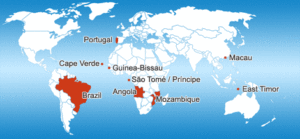 The majority of the ‘new citizens’ originate from Portuguese speaking countries such as Brazil (120.000), Cape Verde (75.000), Guinea–Bissau (35.000), and Angola (35.000). During the same period, a considerable number of Ukrainians (25.000) and Romanians (30.000) settled in the country.
The majority of the ‘new citizens’ originate from Portuguese speaking countries such as Brazil (120.000), Cape Verde (75.000), Guinea–Bissau (35.000), and Angola (35.000). During the same period, a considerable number of Ukrainians (25.000) and Romanians (30.000) settled in the country.
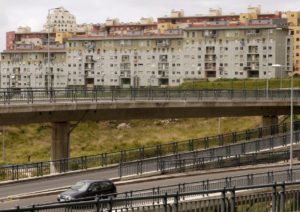
About half of the ‘new citizens’ live in the Lisbon Metropolitan Area, over 60.000 in the sunny Algarve, about 35.000 around Setúbal and 25.000 in the northern harbor town Porto. Lately more Western Europeans – primarily French and English – than Eastern Europeans and Africans are entering the country.
Portugal’s state of security, quality of life and favorable fiscal climate – especially of interest for wealthy pensioners from EU countries – definitively play a role.
It has always been difficult to get a residence permit without a fixed work contract. Yet last summer, the socialist government decided to relax the law allowing migrants with a provisional work contract or even a promise of employment, to apply for a permit. Moreover, immigrants caring for minors and those who are born in Portugal may no longer – according to the new legislation – be simply expelled from the country. A prerequisite, however, is that they haven’t entered Portugal illegally.
 Timothy Macedo – from the NGO Solidaridade Imigrante (SOLEM) – is happy with the new law, but points out that there are more than 30.000 illegals (the vast majority living in Lisbon) and that most of them are waiting for years to be assessed by the Foreigners and Borders Service (SEF).
Timothy Macedo – from the NGO Solidaridade Imigrante (SOLEM) – is happy with the new law, but points out that there are more than 30.000 illegals (the vast majority living in Lisbon) and that most of them are waiting for years to be assessed by the Foreigners and Borders Service (SEF).
Without legal documents, they are condemned to dirty, illegal and badly-paid jobs and deprived of social security. Cynthia Paula – from the NGO Casa do Brasil – also denounces the lack of political will, huge bureaucracy and enormous waiting lists at the SEF, giving rise to unnecessary ‘slow and unjust’ integration and exploitation of illegal workers.
Bom fim de semana Have a great weekend
